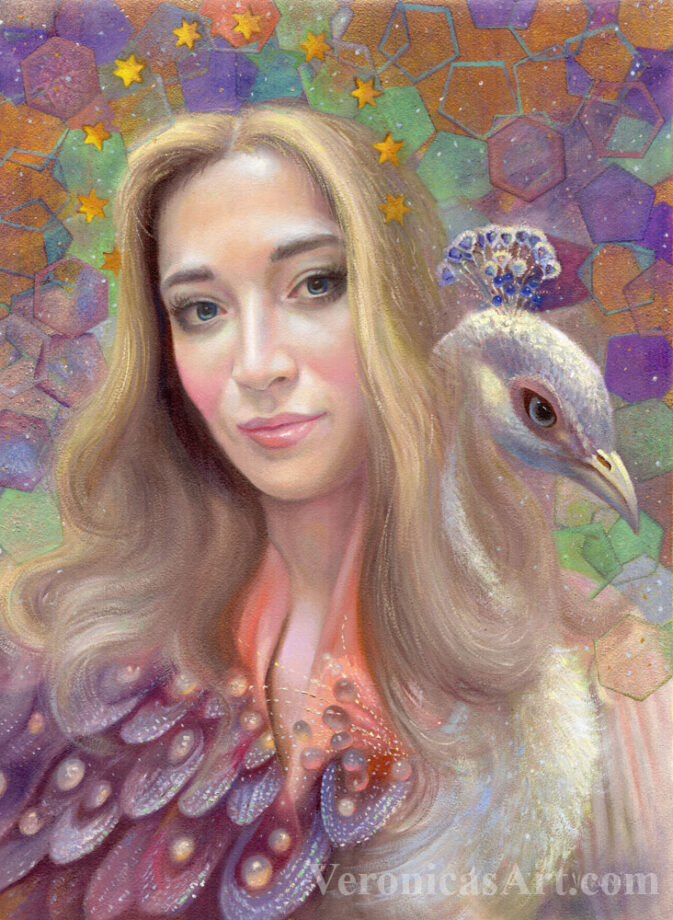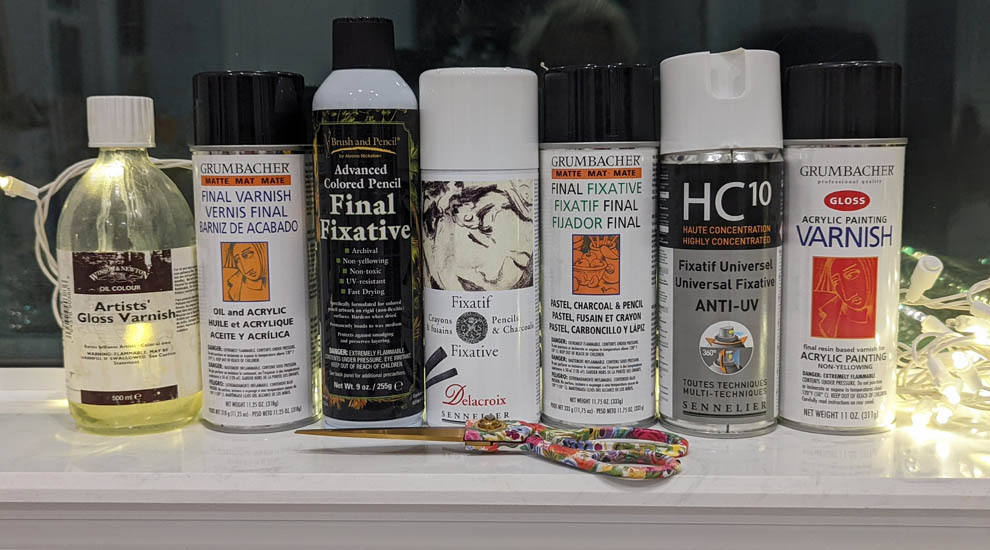Do you know how to varnish art using the varnishes and fixatives correctly? There are numerous videos on Instagram with artists varnishing their art dead wrong. They pour the liquid onto the surface and brush it all over the canvas. I saw one artist at an outdoor art event varnishing her painting in a frame with bugs flying all around her! If you really care about your art and want to preserve it, using your art materials properly is a must. Otherwise paintings may crack or discolor over time.
What’s the difference between varnishes and fixatives?
Key difference between varnishes and fixatives is that varnishes are made for oil and acrylic paintings and fixatives are manufactured for dry media or drawings.
So don’t use a varnish on your drawing! Use final fixative for pastels, pencil, charcoal, colored pencil, and other media on paper, etc. Read labels carefully to decide which fixative or varnish is appropriate for your artwork. A lot of them produce harmful vapors containing acetone and turpentine. However there are some “healthier” alternatives available on the market today. More on that later.
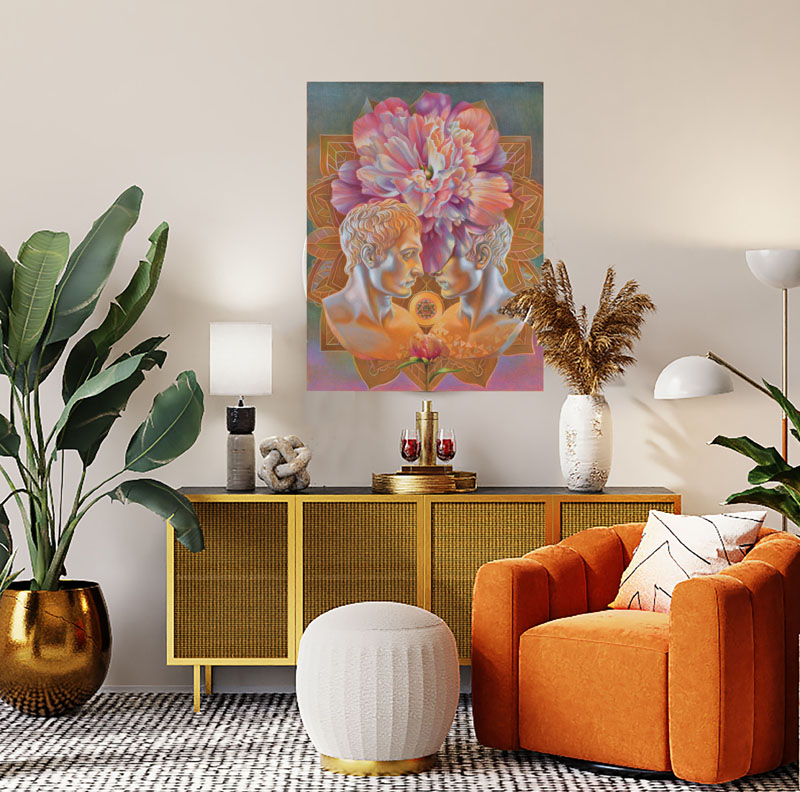
3 reasons to varnish your art
The environmental changes can produce environmental smudge on a surface of the unvarnished oil or acrylic painting that would be very difficult or even impossible to remove later on. One example is the growth of mold on the painting’s surface. Varnishes and fixatives protect your art from UV light, dust and environmental changes. Varnishes are removable, so that a painting can be cleaned and re-varnished, if necessary.
High-quality varnishes and fixatives bring all the colors out in a painting or drawing. The surface becomes nice and even. Colors seem to gain depth and saturation. Personally I love to see how my drawings and paintings transform after varnishing.
How to varnish your colored pencil drawings, pencil and charcoal drawings, pastels and other dry media art
All fixatives come in several denominations - matte, gloss, semi-gloss, etc. Personally, I prefer matte fixatives because the surface becomes nice and even and doesn't reflect the colors. If you like gloss varnishes, know that it takes a lot more fixative to saturate the paper and make it glossy evenly.
- Read directions on the label carefully. Test the spray on a separate piece of paper or magazine page first.
- Spray 15-18 inches away from your drawing, holding the can at an angle. Move quickly from left to right.
- Do short spurs and thin layers. Let each layer dry completely for at least half an hour.
- Spray in a clean and well-ventilated area or outside. Humidity level must be less than 65% in a 55-60F temperature. Otherwise, you may trap the moisture or condensation on the artwork and it would turn cloudy. Depending on the type of fixative, fumes can be hazardous. Once fumes evaporate, bring the artwork inside. I use my bathroom’s countertop to lay art flat and use the bathroom’s ventilator to get rid of the smell completely. Ed S Brickler, technical consultant from Chartpak has a dedicated space in his garage to do the varnishing.
- Workable fixative is often used to increase the texture of your paper. Colored pencils are made of wax and when the surface becomes too waxy and you can’t layer more color, you can spray it with a workable fixative to increase paper’s tooth so it accepts more layers of colored pencil. I often use a very light layer of final fixative to give me this extra layer to work on. I don’t find the workable fixative as useful as the final one.
- I strongly advice against buying cheap fixatives because they give uneven coverage and can ruin your drawings.
- If your colored pencil drawing has some bloom, fix it with a gloss spray first and then use a matte fixative over it. The gloss fixative should even out the surface and get rid of wax bloom.
How to varnish pastels & charcoal drawings
I used to draw in soft pastels before I switched to drawing in colored pencil. Main secret to drawing in pastels is to work from dark to light in layers. Purposefully draw darker in the first layer or two, fix it with a fixative. Then apply lighter layers, fixing each layer. Don’t spray the finished pastel painting heavily because the fixative will darken and change the color. Or use a very light final coat spraying it very lightly.
Drawing with charcoal is about the same. Draw in layers and fix each layer with a fixative.
Don’t spray art if you have sharpie in it. Sharpie will bleed and dissolve.
How to store drawings and art on paper
The best way to store your colored pencil drawings, pencil or charcoal drawings is to lay them flat with glassine paper covering the art. Parchment paper could work as well although the glassine paper is highly recommended and preferred by art professionals. It’s also used for shipping art to create the barrier between unframed art and packaging.
Safe alternatives to traditional fixatives
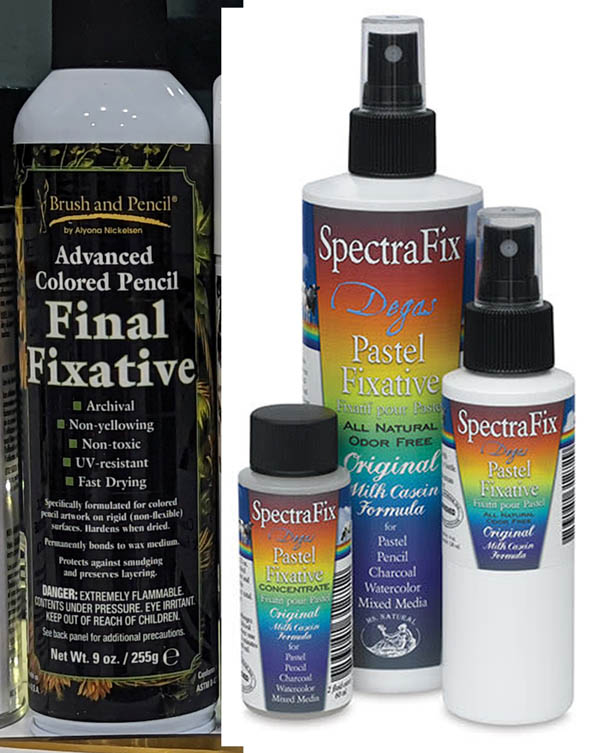
These are the two brands of final fixatives that are made differently and are non-toxic. If you know more about non-toxic fixatives, let me know! I don’t recommend using the Brush and Pencil fixative because the nozzle produces uneven spurs of fixative. It also crumbles thin paper.
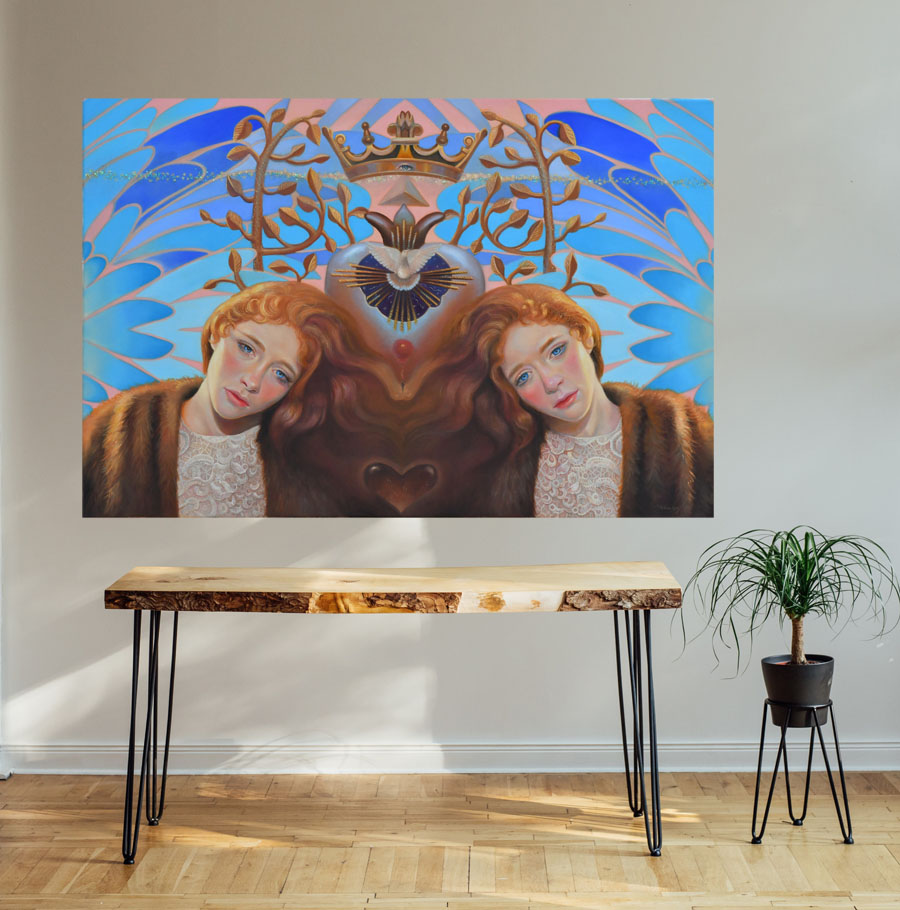
How to varnish oil paintings
Oil paintings must be varnished when the paint is dry completely. 6 months must pass before placing a final varnish over the oil painting. But because of possible environmental damage finished oil paintings can be varnished with a retouch varnish first and then varnished with the final varnish in 6+ months.
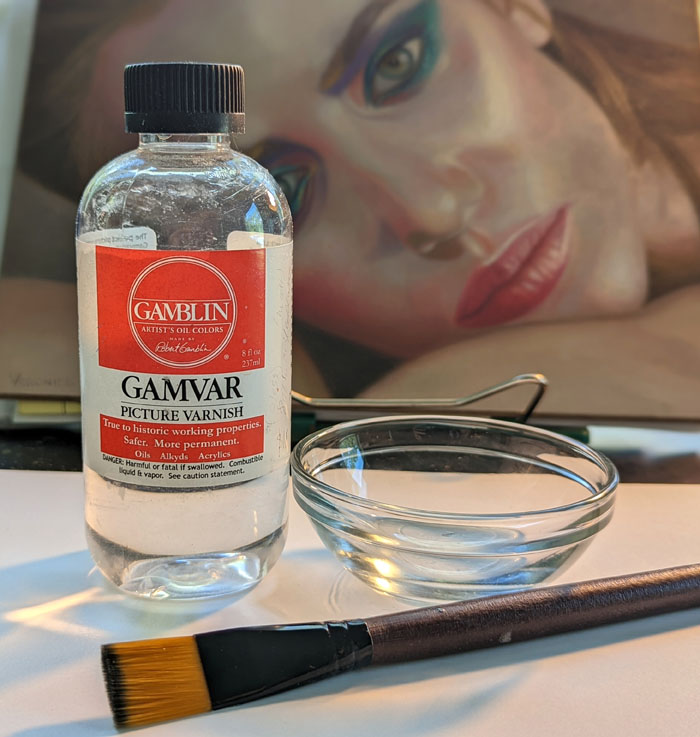
There are two types of varnishes for oil and acrylic paintings – spray varnishes and liquid varnishes. All varnishes come in several denominations – matte, gloss, semi-gloss, etc. Personally, I prefer matte varnishes because the surface becomes nice and even and doesn’t reflect the colors. If you like gloss varnishes, know that it takes a lot more varnish to even out the gloss.
Damar varnishes seem to be dated because they yellow or darken over time. So synthetic varnishes are preferred to preserve paintings from deterioration.
It's difficult to remove the varnish safely if the paint layers are super thin or the painting was varnished too early.

- Your space must be very clean. Liquid varnishes attract dust and particles like a magnet that can settle on a varnished surface. The brush should be high-quality and soft not to leave streaks.
- Pour the varnish into a small and clean glass bowl and deep the brush into it. Start brushing your painting from top left corner moving to the right and then down the painting. You need to be rather quick because the varnish starts drying almost immediately. If you feel that the surface becomes too sticky in one spot, don’t brush over it, rather let it dry. Repeat the process in your second, thin layer moving at a different angle or direction to make sure that everything is covered.
- Varnishes are self-leveling and applying them in thin layers is the best.
- If you use spray final varnishes, apply thin layers, letting each layer dry completely for up to an hour. Also, change the direction with each new layer to cover the entire painting surface evenly.
How to varnish acrylic paintings
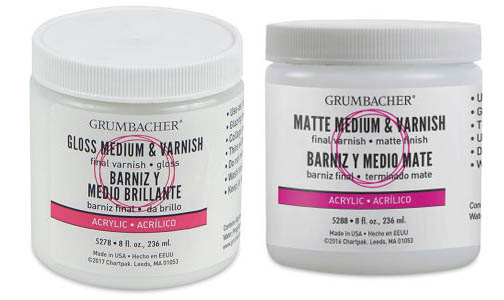
Same rules apply to varnishing acrylic paintings. However, the first thing is to use “medium & varnish” acrylic varnish. Varnish your acrylic paintings in three days with either matte or gloss final varnish over it.
If you gesso your canvases and panels with acrylic gesso or use acrylic underpainting for oil painting, allow acrylic-based gesso or paint to dry for 3 days before starting painting on the surface!
References & resources:
If you’re unsure how to use your particular varnish or fixative, go to the manufacturer’s website. Companies have their own blogs and videos showing how to use their products correctly.
This information is based on my conversation with technical consultant from Chartpak inc- Ed Brickler. You can watch our conversation in a video below. This interview is also available on my Hooked on Art podcast on Spotify & Apple.
Here is a great resource on oil painting varnishing from Gamblin: https://gamblincolors.com/oil-painting/gamvar-picture-varnish/
Amazon links to art supplies I use the most often:
- Drawing pad, bristol vellum
- Kneaded eraser
- koh -i-noor drawing paper, colored pencil
- Tombow mono eraser
- Drawing fixative
- Sennelier fixative for charcoal and pencil has a super fine spray mist, matte, high-quality
- Gamvar varnish for oil paintings, satin
- Brush for varnishing oil paintings
- Color Wheel
- Canson Colorline drawing paper is available in many colors and various thickness. You might find better choices at art supply online retailers
- Molotow metallic marker, gold
- How to color like an artist, coloring book for children and adults
- The colored pencil manual, art instruction book
